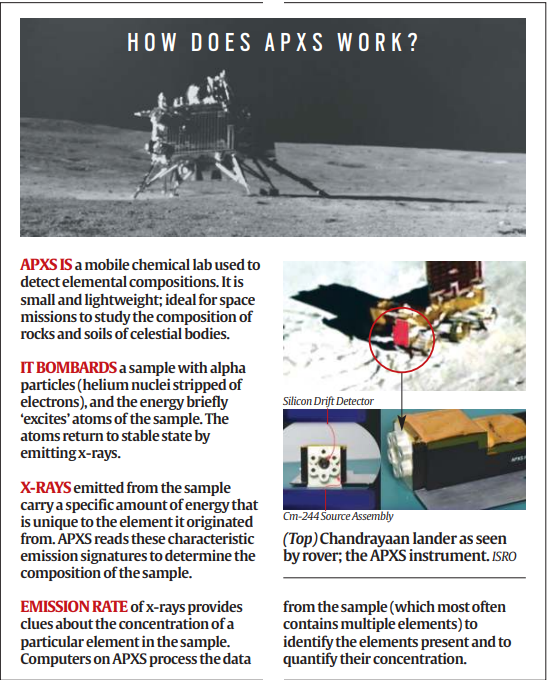(Source: Indian Express; Section: Explained; Page: 10)
| Topic: GS3 – Science and Technology |
| Context: |
- Chandrayaan-3’s findings provide new insights into the composition and formation of the Moon’s southern latitudes, supporting the lunar magma ocean hypothesis.
|
Analysis of News:
What is the Chandrayaan 3 Mission?
- The Chandrayaan 3 Mission was launched using the LVM3 rocket system. LVM3 is the new launch vehicle of ISRO with the capability to place the modules into the GTO (Geosynchronous Transfer Orbit) in a cost-effective manner.
- It is a three-stage launch vehicle with two solid strap stages and one core liquid stage.
- The Launcher, LVM3 M4, placed the integrated Modules in an Elliptic Parking Orbit of size approx. 170 x 36500 km (a GTO).
Objectives of Chandrayaan 3 Mission
One of the many goals of the Mission is to look for water ice that could support future human life on the Moon and also for supplying propellants for spacecraft in future interplanetary missions. The objectives of the Chandrayaan-3 mission are:
- Safe and Soft Landing on the Lunar Surface by the Lander
- Roving on the Moon by the Rover
- In-situ scientific experiments by the Rover

Analysis of Chandrayaan-3’s Findings on Lunar Topsoil
Key Findings:
- Uniform Terrain: The area around Chandrayaan-3’s landing site is relatively uniform.
- Lunar Magma Ocean (LMO) Hypothesis: The findings support a layered formation of the Moon’s crust, reinforcing the LMO hypothesis.
- Mineral Distribution: The topsoil near the lunar south pole contains more minerals from deeper layers than expected.
Significance:
- First Polar Study: Chandrayaan-3 conducted the first detailed analysis of lunar soil near the Moon’s south pole.
- Support for LMO: The data aligns with models suggesting a stratified crust formed from a once-molten surface.
- New Discoveries: Evidence of mixing in the lunar crust, likely due to asteroid impacts, was observed.
Future Implications:
- Calibration Point: The uniform surface could serve as a reference for remote sensing in future missions.
- Further Research: Findings may aid in understanding the Moon’s evolution and guide future lunar explorations.
| Significance of the Chandrayaan 3 Mission |
| India’s Chandrayaan-3 mission aims to continue the nation’s lunar exploration efforts and build on the achievements of previous missions like Chandrayaan-1 and 2. The undertaking holds significance for multiple reasons:
Future lunar exploration:
- The Mission can play a vital role in India’s quest to establish a human presence on the moon.
- The collaboration with JAXA (Japan Aerospace Exploration Agency) for their Lunar Polar Exploration mission (LUPEX) or Chandrayaan-4, etc., will be benefited by the success of this Mission.
Advancing space education:
- The Mission will work towards advancing space education and scientific temper in India.
- It can serve as an inspiration for the scientific community as well as future generations of space enthusiasts.
Lunar Surface Exploration:
- Chandrayaan-2 rеvеаlеd moon details like landscapе, minеrals, and watеr.
- Chandrayaan-3’s landеr and rovеr are studying rocks and soil to understand moon history, possibly revealing asteroid impacts that caused surface changes.
- Focusing on thе moon’s south polе, Chandrayaan-3 aims to find minеrals, undеrground fеaturеs, and watеr, promising frеsh insights into moon gеology and resources.
Scientific Discoveries:
- Chandrayaan-3 carriеs tools to study moonquakes and undеrground hеat. Sеismomеtеrs on its surfacе show thе moon’s interior and thеrmal probеs uncovеr crust movеmеnts, aiding our knowledge of thе moon.
- It will strengthen India’s grasp of lunar gеology, rеsourcеs, and surroundings, deepening insights about cеlеstial bodiеs.
- The Mission sееks to undеrstand sеismicity and thеrmal traits, еnlightеning us about thе moon’s intеrior workings and broadеr cosmic undеrstanding.
Boosting private investment:
- India’s field-tech sector is on investors’ radars with historic growth of private rocket launches and satellite deployments by 2022.
- The accomplishment of the Chandrayaan trio should drive investor confidence higher and attract more private investment in aerospace technology projects.
Job creation:
- India’s booming aerospace technology sector has already created hundreds of jobs.
- Successful lunar missions and subsequent programs are poised to create additional high-tech business opportunities, both directly and indirectly.
Nurturing startups:
- The success of Chandrayaan-3 could be a technology showcase, boosting India’s goodwill in the global space community.
- This could attract joint ventures and business opportunities for Indian companies and startups to develop and develop space systems for the global market.
Strengthening international reputation:
- Successful completion of Chandrayaan-3 will make India the fourth country to land on the moon, earn global recognition and lead to the cost-effective adoption of spacecraft manufactured by Indian companies and proof of its reliability.
- This achievement could lead to useful international cooperation.
Strategic Positioning:
- The success of Chandrayaan-3 could position India as an important player in the international space race, potentially matching China’s influence. With Russia facing economic sanctions, it is an opportunity for India to strengthen its position.
- Together with Artemis Accords, it will enhance India’s ever-increasing space footprints.
|
| Practice Question: How do Chandrayaan-3’s analyses of the Moon’s southern topsoil composition support the Lunar Magma Ocean hypothesis and inform our understanding of the Moon’s formation? (250 words/15 m) |


